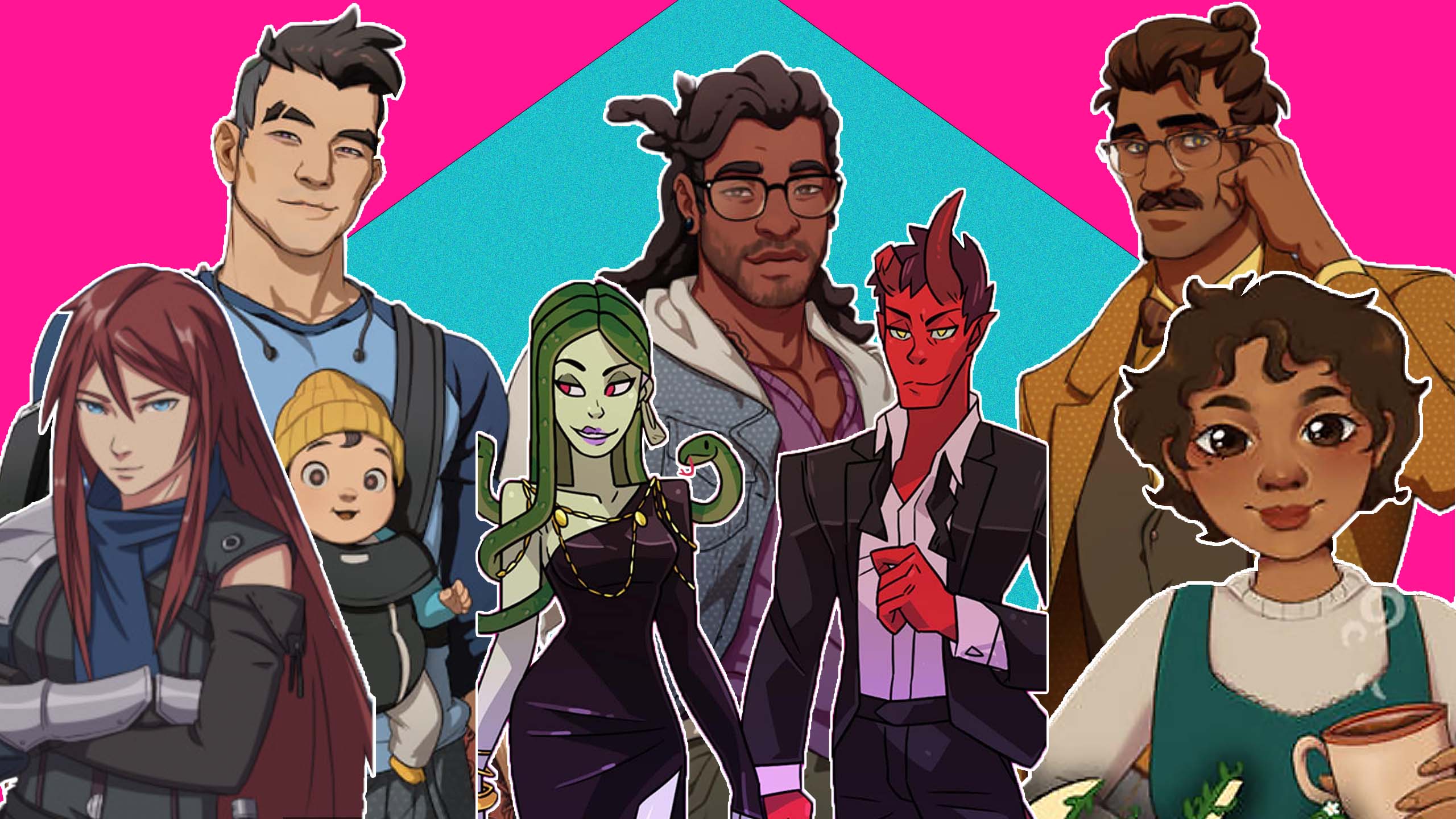InGayming Magazine’s list of LGBTQ2S+ games releasing in 2023 there are a pile of visual novels: of the 26 listed titles with confirmed release dates, 12 are visual novels (and a couple more are fully text-based adventures).
These include titles like Beneath Her Starry Sky, a time-looping visual novel that tasks the player character with tracking down a master assassin and defeating the past. Compare that to the delightfully silly Beeftown Beatdown (where the player needs to win a cooking-slash-wrestling competition), or cozy post-colonial tea-making game Mikiwam: Solarpunk Herbalism from Indigiqueer developers Studio Ekosi, and it becomes rapidly obvious that a visual novel can refer to lots of different things in 2023.
But what are visual novels, why do half of this year’s upcoming queer games share a genre and why is the format so queer?
What is a visual novel?
Visual novels, as a video game genre, refers to games with pretty minimal gameplay. The term originally came from Japan, where visual novels (or VNs) specifically referred to interactive fiction with almost no gameplay at all. The 1983 murder-mystery The Portopia Serial Murder Case, which Retro Gamer magazine said “defined the visual novel genre,” helped lay out what visual novels could look like. The genre went on to become wildly popular, with the J.B. Harold Murder Club series that debuted in 1986, going on to sell 20 million copies in Japan. According to a press release for now-defunct localizing company Hirameki, by 2006, nearly 70 percent of Japanese PC games were visual novels.
These days, especially outside of Japan, the term is more broadly applied to any game that focuses on text-based dialogue and character interaction, even if there are other game elements thrown in. You’re not running and gunning, or jumping across platforms, or fighting epic battles: instead, you’re talking to characters, clicking on conversation choices or maybe solving a few puzzles along the way.
Sometimes visual novels have branching endings that hinge heavily on player choices and incentivize multiple playthroughs to find all the different endings. Other times, visual novels are more like interactive fiction, where you make your way along a linear story. Characters may be fully or partially voiced, adding an audiobook quality. While “visual novel” comes from the Japanese name for semi-interactive fiction with very few gameplay elements, the Western use of the genre term often encompasses all kinds of adventure games that favour story over mechanical complexity.
Ace Attorney and Professor Layton are both well-known Nintendo visual novel franchises where the player solves mysteries or puzzles. More recent standout visual novels include Danganronpa (2010) (which inspired this iconic Kim Chi look), where gifted high school students must murder each other without being found out in order to escape the killing games; and pigeon dating sim Hatoful Boyfriend (2011), which features a cast of literal birds for the main character to date. Dating sims in general, where the player character attempts to romance a cast of curated cuties, are one of the most popular types of visual novels. They’re similar to relationship-point systems that are often present in larger titles—everything from Dragon Age to Fire Emblem to Stardew Valley lets you romance non-player characters, often with the branching dialogue options typical of visual novels.
Depending on length and complexity, some visual novels can take only an hour or two to complete; while others are sprawling tableaus that practically need a step-by-step walk-through to explain how the heck you get that one specific ending.
What queer visual novels are there?
Dream Daddy (2017) is the muscle daddy of queer visual novels. In this dating sim, the player character (a dad) hangs out and pursues a variety of other dads. It’s densely funny, with a range of different character archetypes to satisfy all kinds of gay interests including religious softbois, gym-bro hunks and artsy professors. Developed by popular gaming YouTube channel Game Grumps, the game sold an estimated 472,000 units, received broadly favourite critical reviews, generated a spin-off comic and developed a strong fandom that’s still kicking around years later.
Monster Prom (2018) scratches a similar romance niche, with chaotically pansexual ghosts, ghouls and gorgons desperately trying to find a date for the school dance. Gameplay is super snappy, and there’s a cavalcade of bizarre endings to try and unlock. (Monster Prom has various sequels and side games, so if you vibe with the humour, there’s lots more to explore.)
There’s also an existing pantheon of well-known Sapphic visual novels. Butterfly Soup (2017) and its sequel, Butterfly Soup 2 (2022), follows four queer Asian-American girls navigating high school. Ladykiller in a Bind (2016) is an erotic visual novel (with no-nudity options) that developer Christine Love says is about “girls tying up other girls,” which wades into complex discussions of consent, gender nonconformity and sexuality. And developers Worst Girls Games have two weird and otherworldly titles, 2015’s We Know the Devil (teens at Christian summer camp meet Satan) and 2018’s Heaven Will Be Mine (horny girls pilot cool space robots).
For something a bit more gamified, last year’s GLAAD-nominated I Was a Teenage Exocolonist mixes visual novel relationship-building with deck-building mini-games. Boyfriend Dungeon (2021) combines romancing people who turn into swords, with using said swords to fight through dungeons. (Despite the name, datable characters include non-binary people, women and a platonic relationship with Pocket the cat.)
Why are visual novels so gay?
Video games are notoriously difficult to make. There are so many moving parts to them, including character design, world design, gameplay, movement, camera, music, sound design and story. Big-budget titles from major studios are in development for years, and employ hundreds of people. This means mainstream games, by virtue of the time and money and ad dollars funnelled into them, can also be less willing to deviate from what they think will attract the “average” consumer and individual developers have less opportunity to put their personal stamp on the finished product.
By contrast, indie games are fertile ground for all kinds of diverse, weird and wonderful stories. But they still come at different scales: solo-developed games are rare, due to the sheer amount of stuff that goes into making games, so you’re more likely going to have a team of between a few people to a few dozen. Smaller teams get to put more of themselves into their work, and choose more specifically who they want to target and the kinds of stories they want to tell.
Katelyn Clark, who developed Our Lives: Beginnings & Always (2020), told Digital Trends that the genre is open to almost anything. “Visual novels don’t have to follow any conventions,” Clark said. “It’s a lot of fun.”
And Susan Shu Chang, developer behind 2021’s Death Becomes You (“[Sapphic] murder mystery in a magical university”), said she was drawn to making visual novels both because “narrative-driven games … felt like I was living other lives as if they were my own,” and because the software to develop them was “very beginner-friendly.”
Visual novels are also arguably one of the most accessible kinds of game to create—at their core, they’re built from just character art and text. The stripped-down nature of the genre makes it much easier for solo devs or small teams to create, without needing to be hyper-competent polymaths.
Take one night, hot springs, a visual novel about a trans woman going to a hot spring in Japan with her friends. It began life as part of the Trans Gal Jam in 2018—an annual event where trans femmes (and friends) compete with a limited amount of time to try and make a game. The art is simple, and interaction is sparing: it’s a sweet, slightly sad game about trying to find a place to belong. The game’s developer, npckc, made a full trilogy over the course of the next couple of years, collected as A Year of Springs (2021). It tells a story specific to the developer, not filtered through anyone else’s lens except her own. Similarly, Butterfly Soup was made by a single developer, Brianna Lei; and Worst Girls Games consists of just two queer people, Aevee Bee and Max Schwartz.
Besides the accessibility of visual novels as a development medium, they’re also very accessible to players: no demands are being made on you besides sitting and reading, and sometimes clicking dialogue options. Anyone can play a visual novel, and almost any developer can make one. It makes them ideal for video game newbies and hardened pros alike.
So when looking for new video games to play this year, try a visual novel or two. If you love getting lost in a good book, visual novels offer all the intrigue of a solid story along with the possibility of choosing your own ending—date that sword, go to that spa, or fall in love!


 Why you can trust Xtra
Why you can trust Xtra


